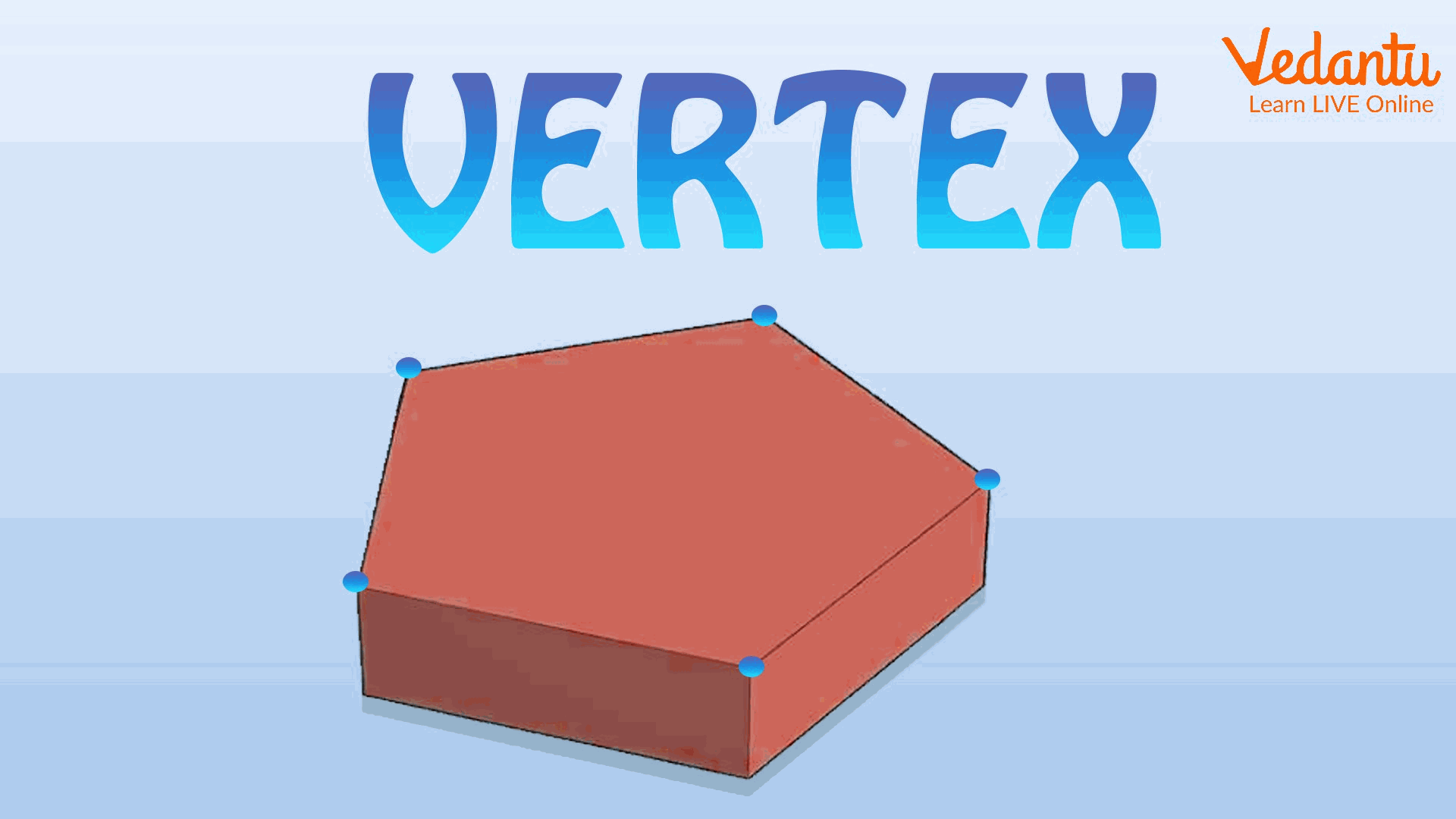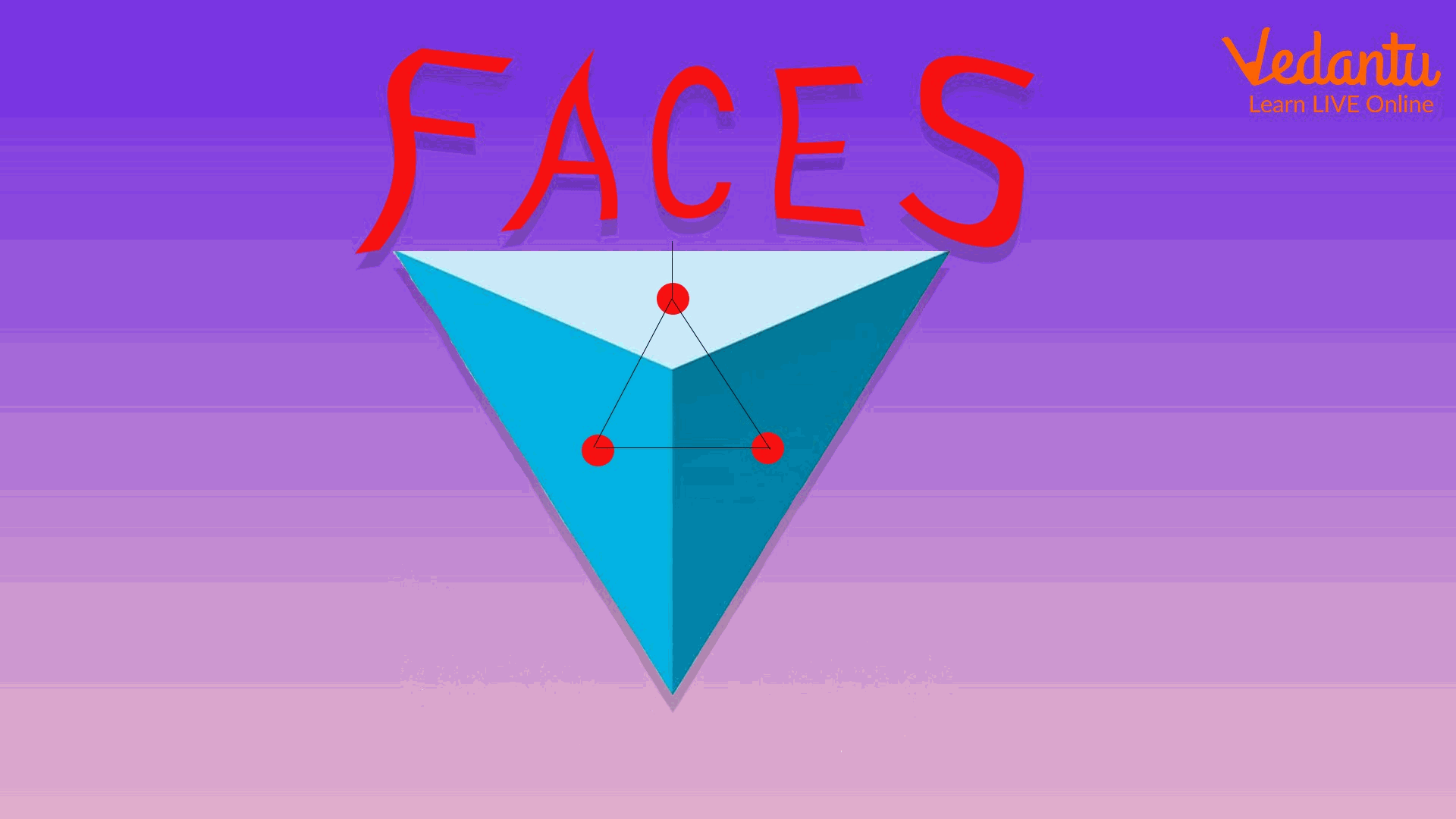




How to Identify Edges, Vertices, and Faces in Common Solids
We see a number of things of different sizes and shapes in our day to day life such as ice-cream cones, balls, boxes and door mats etc. These objects are identified by different characteristic properties. These properties are length, breadth, diameter, perimeter, vertex, edges, faces etc. Edges of any shape are defined as “The line segment that joins two vertices and it acts as an interface between two faces.” In the following diagram, an edge of a square is shown.

Edge of a Square
What are Vertices and Faces?
A vertex of any shape is a point of contact or meeting point of two or more edges. Hence we can say that vertices are the corner points of a shape. The vertex of a pentagon is shown in the figure below.

Vertices of a Pentagon
.
The face of any solid object is any of the individual flat surfaces. The tetrahedron has four faces which are shown below. One face you can not see in the 2-D figure.

Faces of a Tetrahedron
Euler's Formula
The relationship between vertices, edges and faces is given by Euler’s Formula. The Euler’s Formula for many solid shapes is given as : F + V − E = 2
Where F = Number of Faces
V= Number of Vertices
E= Number of Edges
Let’s apply this formula to the cube to verify it. We know that a cube has 6 faces, 8 vertices, and 12 edges
So F=6, V=8 and E=12 then putting these values in the equation we get,
6 + 8 − 12 = 2
2 = 2
Hence the formula is verified.
Numbers of Edges, Vertices and Faces in Different Solids
The number of edges, vertices and faces in different three-dimensional solids are given below.
Conclusion
After reading the above article students will learn basic about what are edges, vertices and faces of any solid. We also learned an interesting relationship between the three of them by learning Euler's formula. This formula holds good for closed solids which have flat faces and straight edges but cannot be used for cylinders as they have curved edges.
FAQs on Understand Edges, Vertices & Faces in 3D Shapes: Formulas, Examples, Practice
1. What are faces, vertices, and edges in a 3D shape?
In any three-dimensional solid, these are the fundamental properties that define its shape:
- A face is any of the individual flat surfaces of the solid.
- A vertex (the plural is vertices) is a corner where three or more edges meet.
- An edge is a line segment where two faces meet.
For example, a simple cube has 6 faces, 8 vertices, and 12 edges.
2. What is Euler's formula for polyhedrons and why is it important?
Euler's formula describes a consistent relationship for all polyhedrons (3D shapes with flat faces and straight edges). The formula is stated as: F + V - E = 2, where:
- F is the number of faces.
- V is the number of vertices.
- E is the number of edges.
Its main importance is that it acts as a check to verify the properties of any simple polyhedron. If a shape's faces, vertices, and edges satisfy this equation, it confirms its structure.
3. How can you count the faces, vertices, and edges of a common shape like a cuboid?
To count the properties of a cuboid (like a rectangular box), you can observe its parts:
- Faces (F): A cuboid has a top and bottom, a front and back, and two side surfaces. This gives it 6 faces.
- Vertices (V): It has four corners on its top surface and four corners on its bottom surface, for a total of 8 vertices.
- Edges (E): There are four edges on the top, four on the bottom, and four vertical edges connecting them, adding up to 12 edges.
Checking with Euler's formula: 6 + 8 - 12 = 2.
4. Can Euler's formula be applied to all 3D shapes, such as a cone or a sphere?
No, Euler's formula is specifically for polyhedrons, which are shapes constructed from flat polygonal faces and straight edges. Shapes like a cone, sphere, or cylinder are not polyhedrons because they have curved surfaces.
- A sphere has no flat faces, edges, or vertices.
- A cone has a curved surface and a flat base, but no edges in the way a polyhedron does.
Because they do not meet the definition of a polyhedron, the relationship F + V - E = 2 does not apply to them.
5. What is the main structural difference between a prism and a pyramid?
The key difference between a prism and a pyramid lies in their bases and the shape of their side faces:
- A prism has two identical and parallel bases (e.g., two triangles in a triangular prism) and its side faces are parallelograms that connect the corresponding edges of the bases.
- A pyramid has only one base (e.g., a square in a square pyramid) and its side faces are triangles that all meet at a single point called the apex.
6. How do you use Euler's formula to find a missing property of a polyhedron?
You can rearrange Euler's formula (F + V - E = 2) to solve for any one property if the other two are known. For instance, if a polyhedron has 8 faces and 12 vertices, you can find the number of edges:
- Start with the formula: F + V - E = 2
- Substitute the known values: 8 + 12 - E = 2
- Simplify the equation: 20 - E = 2
- Solve for E: E = 20 - 2 = 18
Therefore, the polyhedron must have 18 edges.
7. What are some real-world examples where we can see faces, vertices, and edges?
These geometric properties are visible in many everyday objects and structures:
- Buildings: A room is a great example of a cuboid, with walls as faces, corners as vertices, and the lines where walls meet the floor as edges.
- Objects: A dice, a book, or a shoebox are all examples of cuboids.
- Nature and Design: A pyramid in Egypt is a square-based pyramid. A classic soccer ball is a type of polyhedron called a truncated icosahedron, made of pentagonal and hexagonal faces.
8. Are a cube and a cuboid the same in terms of their number of faces, vertices, and edges?
Yes, from a structural standpoint, both a cube and a cuboid have the exact same number of faces, vertices, and edges. Both have 6 faces, 8 vertices, and 12 edges. The only difference between them is the shape of their faces: a cube is a special type of cuboid where all six faces are identical squares.























